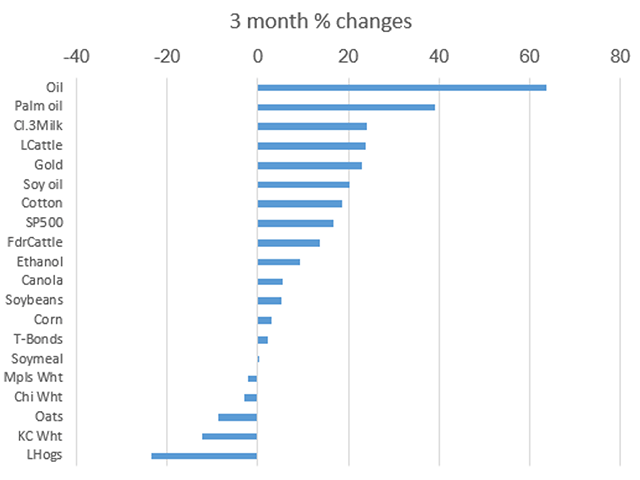Todd's Take
Bullish Exceptions in 2020
As we navigate the first week of August, it is no surprise that 2020 has been cruel to commodity prices in general and to grains, in particular. Coming at a time when surpluses were already common for a broad array of crops, COVID-19 pulled the rug of demand out from under markets and was followed with another hit of recent selling, encouraged by favorable crop weather.
Year-to-date percentage changes in commodity prices show just how pervasive the damage has been as 14 of a list of 18 commodity prices still show negative returns for the year, as of Aug. 6. As far as the coronavirus is concerned, most of the price damage was done by late April and several commodities have had decent rebounds since.
There is an old adage that says it's not the news that's important, but how prices respond to the news. The saying has room for debate, but it is also true that the commodities that rebound from a bearish hit the quickest are often the leaders in the next market phase.
In the past three months, spot crude oil and spot gold prices are two non-ag commodities that have done extremely well. Crude oil is up 64%, thanks to production cuts by a large group of OPEC and non-OPEC oil producers. Gold is up 23%, trading at all-time highs while COVID-19 concerns keep the Federal Reserve committed to an accommodative monetary policy.
The five ag commodities that have fared the best and outperformed the S&P 500 are palm oil, soybean oil, class III milk, live cattle and cotton.
P[L1] D[0x0] M[300x250] OOP[F] ADUNIT[] T[]
Palm oil prices were up 39% the past three months and have benefited from increased demand for vegetable oil generally. In Malaysia, measures intended to limit the spread of the coronavirus have kept out foreign workers with the result that palm oil production is expected to be down this year. The situation has also helped soybean oil prices gain 20% and canola 5% over the same time period.
Spot prices of class III milk are up 24% the past three months, perhaps one of the biggest bullish surprises of 2020. In late April, spot prices fell below $11 per hundredweight, their lowest level in 10 years as restaurants and schools closed. News of perishable milk supplies with nowhere to go were dumped on the ground and created bad press for the milk market. That all changed May 4 after USDA Secretary Sonny Perdue announced $470 million of Section 32 food purchases, including $120 million for dairy (https://www.ams.usda.gov/…). Milk suddenly found an eager market of buyers again and spot prices ran up quickly, peaking at $23.78 in mid-July, the highest in over five years.
Milk prices have backed down since and closed Thursday, August 6, at $16.91. In this case, the best of the bull rally is likely over as the response to the one-time stimulus announcement fades.
Spot prices of live cattle are up 24% the past three months, something that looked highly unlikely in April when COVID-19 concerns were closing down meat plants and leaving ranchers without markets for their expensive, growing livestock. Fortunately, drastic efforts were made to keep plants open and slaughter levels have returned to near-normal levels. The market still needs more time before raising cattle becomes profitable again, but the 24% rebound in the futures market helps.
As a side note, feeder cattle were close to being on this list with a 14% gain the past three months but were 3 percentage points shy of the S&P 500's 17% return.
The fifth ag commodity, cotton, is up 19% since early May, edging out the S&P 500 by 2 percentage points over the same period and attracting positive attention from noncommercials. Cotton prices had been depressed by plentiful U.S. supplies and the trade dispute with China but have gotten more support lately from this year's lower crop ratings and drought in Texas.
I can't guarantee these five ag commodities will continue to perform this well the rest of 2020, but as mentioned above, these impressive displays of technical resilience can be important indicators of the fundamental strength of the commodity markets they represent and are candidates for attracting noncommercial attention.
With the way things started, 2020 may turn out to be one of the most bearish years in U.S. ag history. The track record of the past three months, however, shows that even this year can have some bullish possibilities.
Todd Hultman can be reached at Todd.Hultman@dtn.com
Follow him on Twitter @ToddHultman
(c) Copyright 2020 DTN, LLC. All rights reserved.




